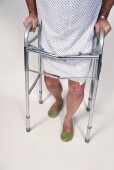 |
 |
 |
||
    |
||||
|
||||

Study Questions Screening for Leg Vessel Blockages
Current guidelines may be set too high to catch disabling peripheral artery disease, experts say|
|
HealthDay
By Robert Preidt
Monday, March 16, 2009
 MONDAY, March 16 (HealthDay News) -- Some people considered normal under current screening guidelines for peripheral artery disease (PAD) may be at high risk for loss of mobility, according to a U.S. study.
MONDAY, March 16 (HealthDay News) -- Some people considered normal under current screening guidelines for peripheral artery disease (PAD) may be at high risk for loss of mobility, according to a U.S. study.
Peripheral arterial disease, which involves narrowed vessels in the lower extremities, can sometimes lead to severe obstructions, known as critical limb ischemia (CLI), a condition in which decreased blood flow causes pain and skin ulcers.
The new study found that people with borderline or low-normal ankle brachial index (ABI) -- the ratio of systolic blood pressure at the ankle compared to that in the arm -- have a twofold to threefold increased risk of physical disability. These ankle blood pressure readings are a common means of diagnosing PAD.
Currently, an ABI value of 0.91 or greater is considered normal. But this study of 666 people found that people with ABI values between 0.90 and 1.09 had higher rates of mobility loss than those with an ABI value of between 1.10 and 1.30, and were more likely to progress to an ABI of less than 0.90 over five years than those with an ABI of 1.10 and above.
The findings are in the March 24 issue of the Journal of the American College of Cardiology.
"This study confirms that patients with ... an ABI value below 0.90 experience significant and progressive loss of function and mobility," study author Dr. Mary McDermott, professor of medicine at Northwestern University's Feinberg School of Medicine in Chicago, said in an American College of Cardiology news release. "But even those with borderline or low normal ABI also appear to be at significantly greater risk of functional declines, including losing the ability to walk up a flight of stairs or walk a quarter of a mile without assistance, compared to people who have no evidence of PAD based on ABI values between 1.10 and 1.30."
She said the findings add to a growing body of evidence that ABI values between 0.90 and 1.09 are clinically significant. Previous studies have found that borderline and low normal ABI values are associated with increased risk of cardiovascular problems and early signs of atherosclerosis.
"This study shows that people we have not previously labeled as having significant PAD, those with borderline ABI values, are at high risk for disease progression and decline in function over time. Given these and other data, the 'normal' value of 0.91 or greater needs to be revisited, perhaps even raised to 1.10," said Dr. Heather Gornik, medical director of the Non-Invasive Vascular Laboratory at the Cleveland Clinic, who wrote an accompanying editorial.
HealthDay
Copyright (c) 2009 ScoutNews, LLC. All rights reserved.
Related News:
More News on this Date
Related MedlinePlus Pages:
| Home | Health Topics | Drugs & Supplements | Encyclopedia | Dictionary | News | Directories | Other Resources | |
| Disclaimers | Copyright | Privacy | Accessibility | Quality Guidelines U.S. National Library of Medicine, 8600 Rockville Pike, Bethesda, MD 20894 National Institutes of Health | Department of Health & Human Services |
Date last updated: 17 March 2009 |
